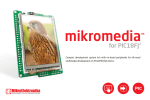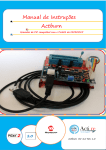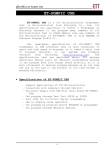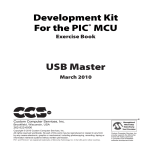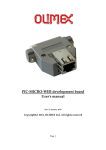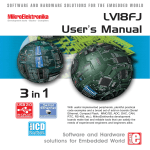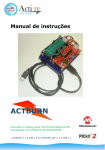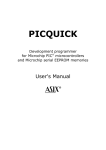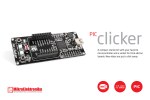Download 18FJprog User Manual v1.00
Transcript
CONTENTS 18FJprog Programmer Software Installation 18FJprog Software Keyboard Shortcuts and Command Line Parameters Programmer’s Operation 18FJprog Programmer Connection Examples of the PIC Microcontroller Connection 4 6 8 9 10 11 13 4 18FJPROG PROGRAMMER Along with complementary software, 18FJprog programmer represents an irreplaceable tool for all those working with PIC microcontrollers. By means of this programmer, it is possible to program almost all PIC microcontrollers including those embedded (soldered) on the printed board. The 18FJprog programmer is connected to the microcontroller via three lines: 18FJPROG PROGRAMMER RB6 - PGC RB7 - PGD MCLR (program clock); (program data); and (high voltage necessary for Flash memory programming). These lines are contained within a flat cable ending with a female IDC-10 connector. When creating a target device, the appropriate 10-pin IDC male connector with the spacing of 2.54 mm between pins should be soldered on it. Connector pins should be connected to the microcontroller pins the position of which varies depending on the microcontroller’s type and package. There are several examples of connection schematic provided at the end of this manual. During operation, the 18FJprog programmer may be inactive or active. Programmer is inactive A multiplexer within the programmer connects the microcontroller pins to peripheral components on the printed board via flat cable. In this way, the microcontroller directly controls the operation of device without affecting the operation of the programmer. Accordingly, even the IDC-10 female connector is connected, the 18FJprog programmer does not affect the operation of device. 5 Programmer is active If the target board has its own 5V power supply, it can also be used for powering the 18FJprog programmer. In this case, it is necessary to open 18FJprog programmer plastic case and remove the jumper J1 for power supply selection and place jumper J2 on 5V as shown on figures below. Otherwise, if the target board does not have its own power supply source, the jumper should be left on. In this case the programmer is powered via programmer USB cable which connects the programmer to a PC. Any other power supply on the target board must be suspended. This figure illustrates the position of jumper J1(left image) when the programmer is powered via USB cable. And position of jumper J2 (right image)when is set to 3.3V if MCU is powered from 18FJprog during programming. Default position This figure illustrates the programmer without jumper J1 (left image) when the programmer is powered by the target board which has its own power supply. And position of J2 (right image)when is set to 5V in order to enable power supply from target board to 18FJprog. 18FJPROG PROGRAMMER By clicking the WRITE option, the multiplexer within programmer disconnects the microcontroller pins from the rest of on-board electronics. It allows programming of the microcontroller using PGC, PGD and MCLR signals. When programming process is completed, the 18FJprog automatically changes its state and becomes inactive. 6 SOFTWARE INSTALLATION Step 1: Start installation SOFTWARE INSTALLATION Insert the product CD into your PC drive. After a few seconds, a list with all MikroElektronika’s products will appear on the screen. To start installation of 18FJprog software, select 18FJprog and click on the Lv18PICFLASH Programmer Software for Windows. You can also download 18FJprog_setup.exe free of charge from our web site. In this case, you should start the installation from your hard drive. A welcome window will appear on your screen. Click Next to proceed with the installation process. Step 2: License Agreement Prior to starting the installation, please review the License terms. To accept these, select the option I accept the terms in the License Agreement and click Next. Step 3: Choose Components For the sake of simplicity, this step of installation offers you only one component to select. Just click Next. Note: Make sure that the 18FJprog programmer is not connected to PC during the 18FJprog software installation. Step 4: Choose Install Location 7 Now you should specify the folder to install the program in. If you want to install the program in a folder different from default, click Browse and select another folder on hard disc. Then click Next. If you choose the default folder, the program will be installed on the following destination: Step 5: Installation Details The 18FJprog installation will start in this step and its progress will be shown on the screen. If you are interested in details about the installation click the Show details button. Step 6: Finish You will be notified by the window, as shown in Figure on the right, that Windows has successfully installed the 18FJprog. Click Finish to complete the installation process. SOFTWARE INSTALLATION C:\Program Files\Mikroelektronika\lv18PICFLASH 8 18FJprog SOFTWARE Step 1: Run the 18FJprog programmer 18FJPROG SOFTWARE Run the 18FJprog from your PC. Click the Device option and select the appropriate microcontroller to program. 18FJprog will automatically set parameters for working with the specified microcontroller. Step 2: Load HEX file Click the Load option which opens the window shown in Figure on the right. Select the appropriate executable file (has extension .HEX in its name) and click the Open option. In this way, the file will be loaded into programmer buffer. On the basis of control bits stored in the HEX file, the 18FJprog will do all necessary settings. Step 3: Write a program Click the Write option in the upper right corner of the working window to start programming the microcontroller. The programming progress will be shown in the right bottom corner of the working window. Keyboard Shortcuts Command Line Alt-E Alt-B Alt-W Alt-V Alt-R Alt-D Ctrl-S Ctrl-O Ctrl-R Alternatively, you can use the 18FJprog programmer from the command line. It will allow you to use 18FJprog from some other software, compiler etc. Here are the command line parameters: -w -v -r -e -p -f -b -Q -Uon -Uoff Example 1 Erase Blank check Write Verify Read Change MCU Save Open (Load) Reload Write to PIC 18FxxJxx Verify Read from PIC 18FxxJxx Erase PIC 18FxxJxx PIC18FxxJxx name (for example PIC18F67J10, PIC18F97J60...) File name (use " as delimiters) Check if PIC 18FxxJxx flash is blank Terminate after programming Force Code protection Force Code unprotect Lv18PICFLASH.exe -w -pPIC18F67J10 -v -f"C:\somefile.hex" This will program the PIC P18F67J10 using C:\somefile.hex and it will verify the write. Example 2 Lv18PICFLASH.exe -r -pPIC18F67J10. This will read the PIC P18F67J10 contents into on screen buffer. Example 3 Lv18PICFLASH.exe -e -pPIC18F67J10 This will erase the PIC P18F67J10. 9 KEYBOARD SHORTCUTS AND COMMAND LINE PARAMETERS KEYBOARD SHORTCUTS AND COMMAND LINE PARAMETERS 10 PROGRAMMER’S OPERATION P ROGRAMMER’S OPERATION Programming an PIC microcontroller is performed using signals PGC, PGD and MCLR from the 18FJprog programmer. These are brought to the RB6, RB7 and MCLR pins. Additionally, the microcontroller pins VCC and GND must be supplied with 3.3V power supply voltage. In order to enable programming to run without errors, make sure that the programming pins are not connected to other electronic components during programming. Otherwise, during normal operation, these pins must be connected to other components as per project. Since the microcontroller is soldered on the printed board (with no use of socket), it is necessary to enable switching over between the programmer and other components using jumpers. For this reason, it is important not to forget to solder an IDC-10 male connector during device design. 11 18FJprog PROGRAMMER CONNECTION IDC-10 male connector and 18FJprog female connector connected On-board IDC-10 male connector The PIC microcontroller power supply voltage is +3.3V.These voltage is provided by the programmer (by default). And it is necessary to provide an on-board regulator, for 3.3V, marked as REG in the Figure above, in order to supply PIC microcontroller when programming is finished and 18FJprog is disconnected from board. If your 18FJprog programmer is not supplied over USB cable, it is necessary to provide additional +5V power supply for its operation. 18FJPROG PROGRAMMER CONNECTION During programming, an IDC-10 female connector should be plugged in the on-board IDC-10 male connector. This connection enables the programming signals to be transferred from the programmer to the microcontroller. Pay attention to the orientation of the female IDC-10 connector. It has to be properly oriented in order to make this programming work. Refer to the Figure below. 12 During normal operation, on-board IDC-10 pins must be connected using jumpers as shown in Figure below. In this way, the microcontroller pins are connected to the rest of on-board electronics. Note that RB6, RB7, MCLR and GND pairs of pins of the IDC-10 male connector are connected using jumpers. You must not connect first pair of pins, which are used for power supply (MCU-VCC +3.3V and VCC +5V) because it can make a short circuit connection and it's possible to damage your device. 18FJPROG PROGRAMMER CONNECTION On-board IDC-10 male connector with jumpers. EXAMPLES OF THE PIC microcontroller CONNECTION 13 Connection schematic for the on-board IDC-10 male connector and 28-pin (SPDIP, SOIC, SSOP) PIC microcontroller such as PIC18F24J10 and PIC18F25J10. EXAMPLES OF PIC microcontroller CONNECTION The following examples illustrates the connection between 28 (SPDIP, SOIC, SSOP); 28 (QFN); 40 (PDIP); 44 (QFN); 44 (TQFP); 64 (TQFP); 80(TQFP) and 100 (TQFP) pins PIC18FxxJxx microcontroller and IDC-10 male connector. EXAMPLES OF PIC microcontroller CONNECTION 14 Connection schematic for the on-board IDC-10 male connector and 28-pin (QFN) PIC microcontroller such as PIC18F24J10 and PIC18F25J10. Connection schematic for the on-board IDC-10 male connector and 40-pin (PDIP) PIC microcontroller such as PIC18F44J10 and PIC18F45J10. Connection schematic for the on-board IDC-10 male connector and 44-pin (QFN) PIC microcontroller such as PIC18F44J10 and PIC18F45J10. Connection schematic for the on-board IDC-10 male connector and 44-pin (TQFP) PIC microcontroller such as PIC18F44J10 and PIC18F45J10. EXAMPLES OF PIC microcontroller CONNECTION 15 EXAMPLES OF PIC microcontroller CONNECTION 16 Connection schematic for the on-board IDC-10 male connector and 64-pin (TQFP) PIC microcontroller such as PIC18F63J11, PIC18F64J11, PIC18F65J11... Note: The following pins RB6, RB7, MCLR, MCU-VCC, VCCcore and GND always have the same position for all 64-pin (TQFP) packages. Connection schematic for the on-board IDC-10 male connector and 80-pin (TQFP) PIC microcontroller such as PIC18F83J11, PIC18F84J11, PIC18F85J11... Note: The following pins RB6, RB7, MCLR, MCU-VCC, VCCcore and GND always have the same position for all 80-pin (TQFP) packages. EXAMPLES OF PIC microcontroller CONNECTION 17 EXAMPLES OF PIC microcontroller CONNECTION 18 Connection schematic for the on-board IDC-10 male connector and 100-pin (TQFP) PIC microcontroller such as PIC18F96J60, PIC18F96J65 and PIC18F97J60.






















